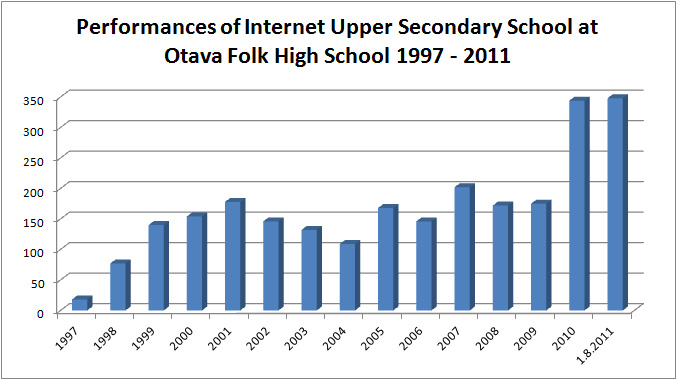Welcome to the Virtual Education Wiki ~ Open Education Wiki
Nettilukio
Nettilukio: Upper Secondary School at Otava Folk High School
Internet Upper Secondary School at Otava Folk High School is a fully virtual school that originates from a project called Internetix. This ESR funded project started in 1996 aiming to find solutions to take school to students instead of forcing them to travel long distances or having to move in order to get to school. In the project eLearning material was produced and special demand seemed to be in upper secondary school courses. The first distance learners of Otava Folk High School started in 1997 - at that point there were 13 students, today 536.
Otava is both national and international upper secondary school operating in Finnish, students living all around the country and world. Typical virtual school student comes from one of the following groups:
- parents of small children
- professional and semi-professional athletes
- people who travel a lot (because of occupation or for other reasons)
- people living abroad
- shift workers
- people who cannot attend school for reasons of health
- people with previous negative experiences like bullying or frustration
- people living in sparsely populated areas
Flexibility seems to be greatest advantage of distance schools. In distance school one can rhythm their schedule and studies to their other life easily. There are no terms or periods, instead each student can study according to their own schedules. There are no obligatory contact days which lead to the fact that most of students never actually visit the Otava campus.
Three types of courses
In Otava Folk High School the students can choose between three ways to accomplish courses.
1. Non-stop-courses
Each student is free to pick any upper secondary school course in his/her schedule any time he/she wants. Courses are always open and the student can choose any courses and study at his/her own phase (i.e. according to his/her personal learning plan). Studying is quite independent and sometimes lonely, too. Even if the studying is independent of point of time, it offers no fast food as the learning always takes its time, no matter how flexible the frames.
Interaction is limited mainly between student and teacher (skype, chat, e-mail etc.).
2. Collaborative courses
Several times a year there are also collaborative courses which begin and end on fixed dates. Booking beforehand is necessary and presence is obligatory. When participating on a virtual class the students are able to work on issues together and use each others as resources. Anyway, also these courses are located in a closed learning environment and they are closed from the rest of the world. Only the students and the teachers have access to the course.
Discussion forums, wikis and virtual conferencing tools are widely used in collaborative courses.
3. Phenomenon based learning
In addition to these two options, Otava Folk High School offers its students courses where they can learn together with other people.
Instead of enrolling in a course in a specific subject such as mathematics, biology or philosophy, the student has a chance to grasp a bigger entity, a real life phenomenon. The phenomena so far studied at Otava are among others hunger and thirst, welfare state, piracy and human being 2.0. The idea is to integrate various subjects in the studying of the phenomenon. The student can choose approach to the phenomenon, set personal targets and thus choose which (upper secondary school) subjects and courses he/she wants to complete.
As the phenomena to be studied are authentic, real life phenomena are the courses also out in an open and public online environment http://ilmiopohjaisuus.ning.com so that people in various roles and with different interests can attend. There are project managers, pedagogues, experts, media tutors, subject teachers – and students, of course. Lurking is also allowed and anyone interested also from other schools and from outside the school world is welcome. The roles are often mixed and the teacher doesn’t have to be an expert in everything. Expertise can be found also outside the school or – as it often is – among students.
Web2.0 technologies (blogs, wikis, video conferencing and social bookmarking) have a lot to offer in this kind of learning and studying. These technologies chance the role of learning (and teaching) towards taking risks, tolerating uncertainty, tolerating incomplete world, flexibility to change plans while on the road.
Read more on these three types of courses using a food metaphor from a blog entry by Taru Kekkonen
Development plans
- Phenomenon based learning: new models and practices are constantly under development
- Mobile learning: within a just starting project ”Mobile learning in an upper secondary school student´s everyday life” six schools are developing and testing mobile learning.
- From closed to open and sharing: development of a new eLearning environment has started and it is going to be open source. Collaboration and sharing are key points of the future environment.
> Finland
> Europe
>> Virtual schools
